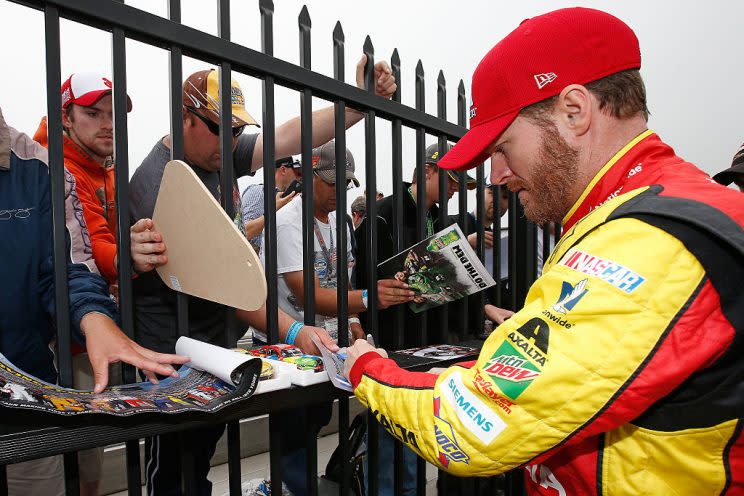Dale Earnhardt Jr. retires as the toughest athlete in sports history
One evening in the summer of 2001, Dale Earnhardt Jr. stood in the infield at Daytona International Speedway, looking up at the banked walls of Turn 4. Tire marks were still there, skid marks that led from the lower edge of the track straight up into the wall. This was the spot where his father had died four months before, and this was where Junior would be racing again in just days.
Dale Earnhardt Jr. stunned the sports world Tuesday with news that he would be retiring at the end of the 2017 season. Concussions, the grind of a never-ending season, the demands that come with being the most popular driver of the last 14 years … they all added up to this inexorable conclusion.
As Junior wheels his final laps, we’ll all spend the next seven months recalling the good times – the victory at that 2001 Daytona summer race, for instance, or the way he became the most accessible athlete on Twitter. But let’s not forget one simple fact:
Dale Earnhardt Jr. is the toughest athlete in sports history.
We love to go on about how tough athletes are when they return to the court after an ACL injury, when they get up from the ice or the grass after taking a hard shot. That’s difficult, yes, bordering on impossible. But those are physical wounds. Imagine, if you can, what Earnhardt had to endure in the days, weeks and months just after his father died on the final lap of the 2001 Daytona 500 while Junior drove on ahead of him.
Junior and his father hadn’t been close growing up; the Intimidator was a tough man to love. But once Junior began racing, a bond formed between the two. By the time Junior raced his way into the Cup series in 2000, NASCAR’s major leagues, and was running side-by-side with his father, that bond had become unbreakable.
Junior was one of the first to realize something was wrong on that terrible February afternoon in 2001, one of the first to get to the hospital across the street from the track. And even after the doctor’s pronouncement that his father had passed, after the sudden national outpouring of grief, after both public and private funerals, Junior still had to strap into a car the next week … and the week after that, and the week after that … right on through till 2017.
Think about that for a moment. Think about what it would take to tamp down your own pain and drive the very track where your father had died. Then think about the fact that no matter where you go, for the rest of your life, people will be reminding you of what you lost, pouring their own grief onto you, expecting you to be someone you’re not.
“Why would someone bring me a photo of my father and ask me to sign it?” Junior, stunned and shocked by grief, would say in those first weeks.
How do you even begin to heal from that?
Time, of course, is the only way. Junior understood that as painful as the continual reminders of his father’s death were for him, they came from a place of love and respect. In those initial years after Senior’s death, Junior was so popular that crazed fans would steal everything from clipboards to tires to half-eaten sandwiches from his hauler. Junior once had a leather jacket ruined by the crush of Sharpie-wielding fans. Even today, Junior commands the largest crowds at any track. And even today, Junior indulges fans of all kinds, like the one who desperately wanted a photo with Junior on Monday at Bristol.
More than 16 years after Senior’s death, time has begun to dull the sharp edges of pain. You don’t see as many Dale Earnhardt Sr. flags and T-shirts at NASCAR tracks, and those you do see are the property of graying race fans. The No. 3 itself has returned to the track after more than a decade’s absence. Junior himself regularly posts old family photos of his father on Twitter. And Junior has become the face and voice of everything NASCAR wants its drivers to be – funny, engaged, competitive, honest, respectful and above all, true to himself.
NASCAR’s going to miss the hell out of Junior when he’s gone; you could make a strong case that he was more popular – or at least more universally beloved – than his father ever was. Sure, he trails his father in championships won, 7 to 0, but it’s virtually impossible to find anyone with something bad to say about Junior. Losing him after losing Tony Stewart last year, and Jeff Gordon the year before that, will present a challenge unlike any NASCAR has ever known. But that’s someone else’s story now; Junior’s on-track career is winding to its conclusion.
Dale Earnhardt Jr. grew up in the harshest spotlight imaginable, and against all odds, he thrived. He’ll likely be around the sport for the rest of his life, encouraging younger drivers, recalling the good times, and still taking selfies with fans. But there will never be anyone else who will have to shoulder the burden he did. No one could have done it better.

____
Jay Busbee is a writer for Yahoo Sports and the author of EARNHARDT NATION, on sale now at Amazon or wherever books are sold. Contact him at jay.busbee@yahoo.com or find him on Twitter or on Facebook.
More from Yahoo Sports:
• Dale Jr. announces stunning NASCAR retirement
• The anti-fascist movement in U.S. soccer stadiums
• Game 4 over early as Warriors complete sweep
• The story of the Colts’ historically bad 1992 draft

